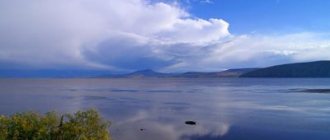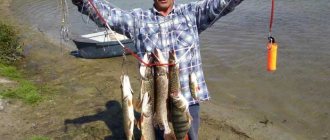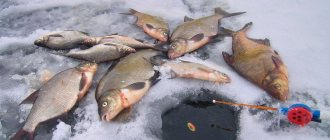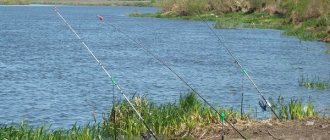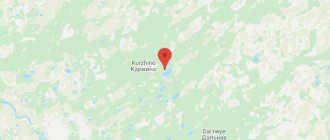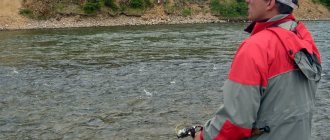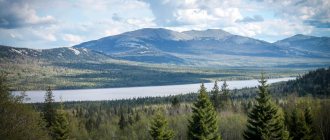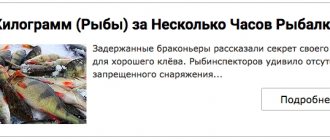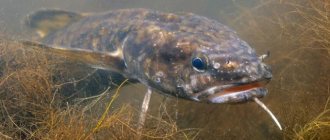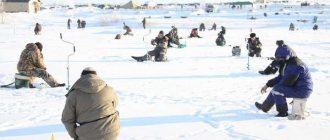Today I want to tell you about carp fishing in the Chelyabinsk region. It is best to do this in the summer. However, do not forget that since mid-June there has been a ban on fishing from a boat and in the bays. Because this is the time of fish spawning. My travels in search of fish will probably seem reckless to you. But distances don’t scare me, I love visiting distant places, and I’m simply drawn to trophy fishing for carp and any other fish.
For me, carp fishing in the Chelyabinsk region began with a long train ride with all the equipment. After reading reviews from experienced fishermen before the trip, I decided to first go to Lake Bolshoy Kremenkul. This reservoir is located on the northwestern outskirts of the city. Despite the proximity to the regional center, the water is quite clean and large trophies are found here. In addition, it is very convenient to drive up to the fishing spot; you don’t have to worry about off-road conditions. My carp fishing began on the paid beach of this lake. The float is my favorite assistant in business, but, as experienced fishermen advised me, there is nothing to do with it here. I was also advised not to forget about the current rule at the time of spawning: no more than two hooks per angler. It turns out sparsely, but the law is the law.
Fishing for carp: reservoirs that were recommended to me to visit
Before the trip, I read a lot about fishing spots in the region and, in addition to the lake described, I selected several more places for fishing:
- Treustan – huge expanses of water and a lot of fish. Next time I will definitely come here;
- Ipkul - they say it is a very picturesque reservoir, but to fish you need to purchase a ticket;
- Sunukul is a small but very well-kept lake;
- Kaldy – recommended for pike lovers.
Results of my trip
I spent 3 days here and was very pleased. The weather was warm and windy, and during my stay I met local fishermen. My carp fishing is over, but I have become aware of new bodies of water, and I will definitely return here. Well, my most important trophy is an eight-kilogram scaly beauty.
In general, I want to say that the Urals are a very interesting place for a fisherman. In addition, the nature here is extremely picturesque, which simply obliges everyone to visit here. In addition, here you can go on various excursions, and along the way there are such beauties that you can’t take your eyes off.
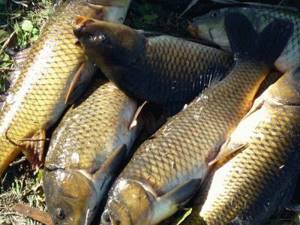
His Majesty carp is the most popular fish in the Southern Urals! Why carp? Firstly, this is the main representative of the large carp family, which by its nature is well adapted to our climatic conditions. From here it quickly gains marketable weight. Secondly, its fish flesh has wonderful taste. And if your head is the size of a chef's hat, you can't avoid licking your own fingers. Well, and most importantly, this is a worthy fighter, when fishing, fishing rods crack and knees shake. What else do we fishermen need?!
Simple (carp), mirror, naked - there are many varieties of carp, but the essence is the same. For the most part, they are all “brothers and sisters”, born in “test tubes” of fish factories and released into the wild. Naked, mirrored - what's the difference! Only lazy cooks believe that mirror carp is tastier than regular carp. Misconception! It just has fewer scales and is easier to clean. But it is for sure that carp caught from different waters have different taste qualities.
Such simple categories: the size and depth of the reservoir, the chemical composition of the water and food supply, the presence of flowering flora and rotting flooded forest - all this affects the taste of underwater inhabitants! And it’s sad when the cooked fish soup smells not like fire, but like dust. But what is much worse is that you cannot see the presence of radiation and heavy metals in the eyes of the caught fish. Well, okay, the foreplay is over, and as Ostap Bender used to say: “Mother, let’s go to the bins!”
Lake Tishki . Carp 0.3–5 kg, ticket 300 rubles. The fish is clean and tasty. Today, the carp are not in the reeds, but in the lake, so normal fishermen have long been based on the clean reeds (100–800 meters from the lake edge), and only the booties still huddle close to the shore, exterminating 200-gram small fish.
Lake Urefty. Carp 0.6–3 kg, ticket 150 rubles. Despite the decent weight, the carp here is not fat. Apparently, this is due to the “dead” food supply. Today the best fishing is using donkeys (casting rods, spinning rods) from a boat in the area of the spring, 200–300 meters from the shore. The reeds have small change.
Lake Kainkul. Carp 0.2–5 kg. I haven’t been there myself, I won’t lie. But my friends brought back a lot of fish and impressions from there. Worth a try!
Lake Chebakul . Carp 0.8–5 kg. The fish is fatty and tasty. Fishing in the far right bay (from the village of Chebakul) and in the clean one, not far from the bay. Apparently, the carp in this reservoir were not completely swept away, so they still stick to shallow depths.
Lake Uelgi . Carp, silver carp, grass carp (0.8–24 kg). It’s a good lake, but the funny thing is that when hunting for predators, only bee-eaters visit it. Apparently, no one knows that this reservoir has been actively stocked with fish from the carp family for a long time, and the fish here are truly trophy! All you have to do is adapt!
Lake Aydykul (Aktyuba) . Carp 0.5–16 kg, ticket 350 rubles. Fishing on large patches of grass. The lake water area is large, so it is advisable to have an outboard motor for the boat.
Lake Agachkul (Sultaevka) . Carp 2–12 kg, the biggest gourmet in the Chelyabinsk region. Here, regular canned corn often doesn't work. Today the fish take only semolina with a worm attached, and tomorrow - on steamed “stars” from homeless bags. Fishing for donkeys from the shore, and luck does not come to everyone and only in a stormy surf.

Lake Sagishty (Sultanovo) .
The carp, 2–10 kg, was stocked six years ago, and since then, except for local villagers, no one has caught it. Apparently, the proximity of the Russian Techa and the general fear of radiation had an effect. Recently it turned out that the “Mayakovsky trace” did not touch this reservoir, and a real pilgrimage began here. Of course, in six years the fish has grown considerably, but, as it turned out, it is not easy to catch it. In any case, the monsters of this reservoir are too tough for booties - there are too many fishing subtleties! Lake Tirikul . Carp 5–16 kg, caught on a fishing rod only in favorable weather and only in certain reed places. Fishing here is somewhat akin to hunting a snow leopard. Just as forbidden and often hopeless! You can feed fish for weeks and not see a single bite. But signs prohibiting commercial fishing are on all banks. Regarding carp, this lake is only for “pros”.
Lake Treustan. Carp 0.6–14 kg, until July, in terms of its taste, it is simply a delicacy. But with the onset of summer heat, flooded forests begin to “wander.” As a result, the fish also begins to smell of dust. At the end of August, the water cools down, and everything returns to normal - the carp becomes edible again. From the story of the fishermen: this season, in the middle of the lake, they picked up a drifting net, torn from the anchors, in which there was a carp weighing 34 kilograms. I don’t know whether they’re lying or not, but what I bought for is what I sold for. So draw conclusions about the size of the local fish, which sometimes breaks fishermen’s fishing rods (including me).
Lake Atkul. Carp 0.6–8 kg, quality fish relative to the frying pan. The ticket costs 150 rubles. If you approach fishing (from a boat) in a working way (0.2–1 km from the shore) plus 4–6 donks (spinning rods), you can load the fish tank well. In this case, you need to look for carp by its characteristic splashes (candles). In the absence of these (blind search), you will have to work hard: each stop with thrown gear takes one and a half to two hours. If there are no bites, you need to move 100–200 meters towards a gradual increase in depth. Empty again - that means further... Of course, this type of fishing is not for amateurs who are accustomed to drying their “fins” on the shore, sitting with beer under umbrellas.
Lake Tukwanda . Carp 1–12 kg, round and from the outside somewhat reminiscent of bream. The fish, as in every bitter-salty lake, is very tasty. We've been here twice - the fishing is excellent! The left side is a continuous spawning shoal, the right side has decent depths. The problem is that this lake is under the jurisdiction of the military (a training ground), but there is a rumor that the lake has been opened.
You can also catch carp in the lakes Bolshoy Kremenkul , Kurochkino , Sineglazovo , Kasargi , Shelomentsevo , in the ponds of Nizhniye Karasey ... So where can you go fishing to catch a wonderful fish, the name of which is carp?! I will say without any secret - the direction is not important! The most important thing is that we were all born in the Southern Urals, in a Russian corner of hundreds of rivers and thousands of lakes. By and large, we have nowhere and no need to go - we’ve been in a cool place since birth!
Where and what to catch in the Chelyabinsk region
Basically, we must admit that the most promising places for a fisherman from Chelyabinsk are lakes. They are caught both from the shore and from a boat. Thickets of reeds and reeds are a feature of many local reservoirs, but more fish can be caught in these thickets than in open areas.
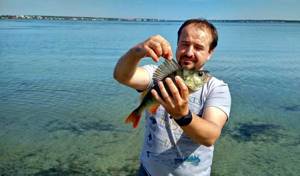
The most common fish here is crucian carp. It lives almost everywhere, withstands long winter periods with poor oxygen supply and finds a lot of food in reed thickets. Among the sporting methods of catching it, a float rod is used. But locals more often poach using tops - I must admit, this is one of the most effective ways of catching crucian carp in the thickets.
- Big Kuyash. An extensive reservoir with a depth of no more than 3-4 meters. The reservoir is paid, the cost is 100 rubles per day. The original inhabitant is only crucian carp, which is the most abundant here. But recently, fish species such as carp, whitefish, and peled have been introduced.
- Ulagach. The lake is located near a thermal power plant, so there is a large area that does not freeze even in winter. They fish here with jigs and spinners. The main prey is pike. There are also other types of fish - traditional crucian carp, whitefish, perch and carp. Fishing is free.
- Urefty. The lake is paid, 250 rubles per day. The depth is small. The lake is regularly stocked with many species of fish, but the only local inhabitants here are crucian carp. There are a lot of ducks on the lake, even its name is translated from Bashkir as “Duck”. Coastal areas are heavily overgrown and snarled, and the depth is shallow.
- Nyazepetrovskoe reservoir. It was formed in the post-war period after the construction of the dam. The reservoir is of semi-river type, has a weak current and great depth - up to 18 meters. The lake is famous for perch and bream, which can be caught both in summer and winter. There are many other fish species that are frequently stocked. Fishing is free.
- Quiet. The lake is quite large, but shallow. The depth is three meters, there are holes up to six meters. The banks are flat, marshy, and clayey. In rainy weather they are very washed out, so it is often difficult to drive even within the permitted 200 meters to the lake even by truck. The lake is regularly stocked with carp and grass carp, of which there are plenty of them. They get hooked by fishermen. They fish with fishing rods, donks, feeders, from a boat in a plumb line and other permitted methods.
Where do carp bite in the Chelyabinsk region?
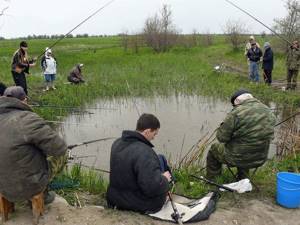
Fishing is a favorite recreational activity for millions of men. And women often began to look at the reservoir, not with the purpose of swimming. Their main desire is to catch a fish, and more of it. There are so many different types of it. And bream, and pike, and perch. The list can be endless. However, carp is the most popular of all. And which one will take the bait today is a mystery to everyone.
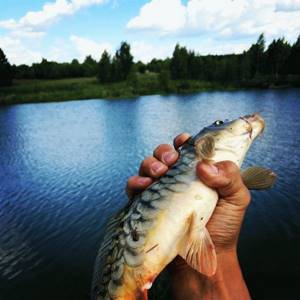
The largest carp that was caught with a fishing rod weighed 120 kg and was almost 2 m long. The fish turned out to be an old man, although it did not look 12 years old. Such a giant was caught in Bangkok, and when it was weighed and measured, it was released back.
In general, the fish is very prolific. This is probably why it got its name. Translated from Greek, carp means fruit. In some areas, for example, this type of fish was and is known as korop. It lives mainly in lakes and ponds and feeds on plants, mollusks, and insects.
Fishing on the rivers of the Chelyabinsk region
Most of them are small. The nature of the river flow is usually mountainous. At one time, hazardous enterprises operated in the region. Metallurgical enterprises in the region also contribute to pollution.
Yuryuzan River
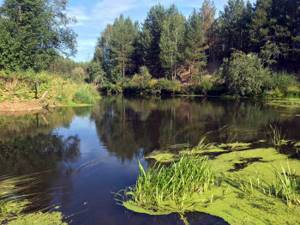
Yuryuzan is one of the longest rivers that flow through the region. Translated from Bashkir, the name of the river means “big river valley.” The river is very picturesque and flows partly through mountainous and partly through flat terrain. There are minnows, chubs, ides, and roaches. It belongs to the Caspian water basin, so some subspecies of sterlet and other migratory fish can come here. However, catching them on the river is very rare. They fish here using a feeder and a float. The river is not wide, you can fish on it using ordinary float gear, reaching up to the dump.
Bolshaya Karaganka River
Big Karaganka. The river has a fast flow, almost mountainous. It has a number of rapids and many riffles. This river attracts fishermen with its picturesque banks and aquatic fauna. Among the inhabitants of this river are minnows, chubs, and graylings. Locals successfully catch minnows with tyrant-type gear. You can use a donka with an elastic band, modernized for a tyrant, or a drop-shot type jig. The lower reaches are inhabited by pike and roach, and in places overgrown with reeds you can successfully catch crucian carp, golden and silver.
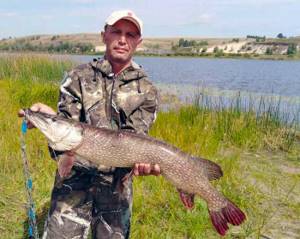
Uveika River
Refers to small rivers. It flows to the south of the region, where the environmental situation is favorable. Like most other rivers in the region, it has mountain and semi-mountain flows. There are a lot of minnows in the river, there are perch and pike. Most of the rivers in the region, except for the Yuryuzan and a number of others, belong to the basin of the Iset and Tobol rivers, which flow to the north.
Miass River
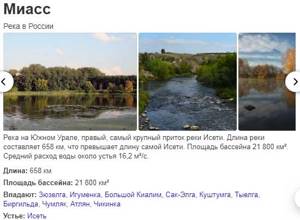
The largest river in the region. It has a fairly calm current and does not have many fast riffles. The bottom is rocky and sandy. There are several large regional cities on the river, such as Miass and Chelyabinsk itself. Here you can comfortably fish with a normal serious feeder, catch bream, crucian carp, and a number of other fish.

Attention! Unfortunately, not all rivers in the region are safe. In the north of the region, the Mayak enterprise existed for a long time, which poisoned the Techa River with waste. The same can be said about other bodies of water that have fallen into a terrible state as a result of the activities of similar facilities. Therefore, fishing in rivers should be carried out with caution to avoid cases of poisoning from the caught fish. Although there is a lot of it here. Fishing is a form of recreation that should bring health to a person.
Where is the best place to look for carp for a successful fisherman?
This fish prefers deep places with slow- moving or standing water. Selects muddy bottom. Carp can also be found in areas with a hard bottom, but avoids rocky places. Ponds with warm water overgrown with algae are the favorite habitats of carp.
Living in the Chelyabinsk region is already a gift of fate. After all, only here there are so many clean and living bodies of water. Each lake is famous for its legend, flora, fauna and landscape. Even just to enjoy it all, to breathe a breath of fresh air and complete freedom, it’s worth leaving the city. Each lake has its own secrets for catching big fish.
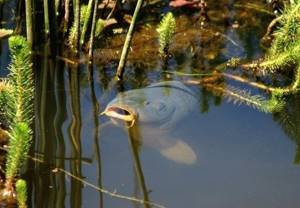
Lake Tishki . Here you can catch carp weighing from 0.3 kg to 5 kg, paying 300 rubles. The fish is tasty, clean, and does not have the unpleasant smell of a swamp. Today, carp live not in the reeds, but in the lake, so fishermen sit at a depth where the water is cleaner, away from the lake edge of the reeds, and only a few still sit at the shore, which rewards them with 200-gram small change.
Lake Urefty . Medium, but lean carp up to 3 kg, the ticket costs 150 rubles. It is better to catch a large specimen using bait and only from a boat, away from the shore. There is nothing to catch near the reeds, except perhaps small fish. The catch from this lake is enough to feed a family or to sell.
Lake Kainkul. Having visited this reservoir you can catch carp weighing up to 5 kg. You shouldn't sit at home and wait for miracles. You need to go to Kainkul and catch these miracles! Moreover, fishing on this reservoir is allowed for free. It is better to place donks along the southern and eastern shores. If you wish, you can rent a boat on the shore and fish from the boats.
Lake Chebakul . Carp 0.8–5 kg. The fish is tasty and fatty. Most of the fish swim near the shore, at shallow depths. Fishing is good on the right bay near the village of Chebakul, and on the clean one, not far from the bay.
Lake Uelgi . Once you get the hang of it, you can bring back some good trophies from this lake. Grass carp, silver carp, carp with good weight from 0.8 to 24 kg. You can fish both from a boat and from the shore, but first you will have to pay 250 rubles.
Lake Aydykul (Aktyuba) . Sometimes carp reaches incredible sizes - 16 kg. The smallest one stretches 0.5 kg. Here the ticket is more expensive - 350 rubles. The fish is splashing well in the grass. The area of the lake is large, so it would not hurt to have a boat and a motor for it. The lake was opened for fishing only in 2010. The caught fish always pleases the eye with its size, taste and smell.
Lake Agachkul (Sultaevka) . Carp are not easy to catch on this lake. The smallest is 2 kg; there are species up to 12 kg. The biggest picky eater. Today he eats corn, tomorrow he eats semolina balls stuffed with worms, and the day after tomorrow he “orders” steamed pasta from instant soups. They fish mainly on the shore. Great luck smiles only in bad weather. A storm wave will drive the fish into the net. And yet, this does not reduce the number of people who want to go fishing from the shore.
Lake Sagishty (Sultanovo) . For six long years, no fishermen came here except local ones. Everyone was afraid of radiation. So, the carp grew to 10 kg. But to catch a good fish you need to have skill and know some of the subtleties of fishing. Fishing with gear with animal and vegetable bait. Carp are caught well on the last ice, when they begin to become oxygen starved and they swim up to the opened ice.
Lake Tirikul . Carp from 5 kg. Under good conditions, an individual weighing up to 16 kg can bite. Here they hide in the reeds. Although fishing here doesn’t cost anything, it’s not that easy to catch either. Therefore, it is better for beginners to choose another place for fishing. Well, for the pros, the best place for fishing with a fishing rod is the southern and western coast.
Lake Treustan. Average carp from 0.6 to 14 kg. To prevent the finished fish from giving off an unpleasant taste and smell, it is better to catch it before the heat sets in. As soon as the forest swamp begins to rot, waterfowl become “unsuitable” and you can forget about fishing until mid-August. With the return of cold weather, carp regains its taste. According to fishermen, it was on this lake that a carp weighing 34 kg was caught. Anyone who wants to try their luck and catch a large carp must first pay a fee of 150 rubles.
Lake Atkul. Carp splashing here weighing from 0.6 to 8 kg, very suitable for frying and stewing. A fishing trip costs 150 rubles. If you want a quiet fishing holiday, then you shouldn’t even visit this body of water. Fishing here is more for active fishermen. If there are no characteristic splashes, then you have to fish blindly. Having thrown the gear, you have to wait 1.5–2 hours. If the result is negative, you need to move 200 meters in the direction of increasing depth. And so on until the fish finds its hook. The last time the lake was stocked with carp was from 2006 to 2008. Fed with bread, corn, and boiled potatoes.
Lake Tukwanda . In this place, the carp are large. If you are very lucky, you can catch 12 kg of fresh, tasty fish. On the left is a shoal suitable for spawning, but on the right side you can fish. For a long time, the lake was under the supervision of the military, so fishing was difficult. But today the lake is waiting for its fishermen heroes.
Another body of water in the Chelyabinsk region that carp fishing lovers should visit. The catch will most often contain medium carp.
But the list of lakes in which this fish is found does not end there. You can catch carp in almost every lake. And it doesn’t matter whether you go to Bolshoy Kremenkul, Sineglazovo, Kurochkino or Lake Kasargi. In any case, you won’t leave without a lake gift in the form of carp.
Fishing and recreation in the Republic of Kazakhstan Excitement always means a good bite and excellent trophies. We will try to make your vacation carefree and enjoyable!

Fishing Complex Azart is a great choice for your holiday! In a word - come, you won’t regret it.
RK Azart is: - 10 stocked reservoirs - Large assortment of fish by variety and size (trout, sturgeon, catfish, tench, pike, pike perch, carp, perch, etc.); — Equipped places for fishing (fishing platforms with a gazebo (without a gazebo); — Places for relaxation (gazebos with tables and barbecues, hanging swings); — Guest houses and a hotel for proper rest and accommodation; — Russian bathhouse with a banquet hall; — Free parking;
RK Azart is located 70 km from Chelyabinsk along the M5 highway in the direction of Ufa, district of the village. Herbalists, own parking lot, rental of everything you need on site.
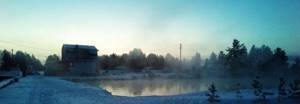
The fishing complex invites nature lovers to feel the real excitement of amazing fishing in the Chelyabinsk region, have a pleasant time in a Russian bathhouse, take a breath of clean forest air and be alone with nature in a comfortable guest house. Come light - without thinking about packing and preparations - we will take care of everything.

On the territory of the Azart Fishing Complex there are gazebos with rental equipment necessary for fishing, guest houses and a hotel, as well as a real Russian bathhouse. The complex is located on a spacious, unfenced area, which allows us to fully preserve the natural beauty of our places.

Stocked reservoirs, unlike an aquarium, do not offer easy prey - you are guaranteed the opportunity to show all your fishing skills and experience the real thrill of the hunt. Carp, trout and sturgeon for an experienced fisherman will be a well-deserved reward for patience and work!

You will be pleasantly surprised by the price/quality ratio and the variety of services provided. Just imagine how incredibly tasty charcoal-grilled carp or trout will be, prepared with your own hands from your catch!

You can also spend the night in our Guest Houses and Hotel.

If you are planning to spend a day or two in RK Azart, you can be sure that a wonderful vacation is guaranteed to all guests
The fishing complex in the Chelyabinsk region offers the following types of recreation: fishing on paid reservoirs, family and corporate recreation. We invite you to RK Azart, spend time and relax in nature in the Chelyabinsk region. You will find very cozy and comfortable 2 and 3 bed hotel rooms, 6 – 10 bed guest houses, and equipment rental. You can relax, relieve fatigue, or vice versa, hold a banquet in a warm, comfortable atmosphere in a chic Russian wood-fired bathhouse.
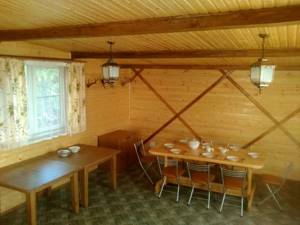
Accommodation in RK Azart offers comfortable 2-3 bed hotel rooms and 6 (up to 10) bed wooden two-story guest houses with verandas. Each room has a separate entrance: bathroom, bath or shower, plasma TV with satellite TV, refrigerator.
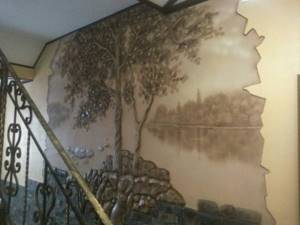
Guest houses are additionally equipped with comfortable kitchen furniture and equipment; in the hall there are large sofas that can be used as additional beds. All rooms and houses are connected to gas heating, water supply is provided from our own wells with a multi-level water purification system.
We also took care of barbecue lovers by placing a large gazebo with barbecue right by the water. You will have an unforgettable meal enjoying the beauty of the Ural nature.
Barbecue areas are equipped in each Guest House, so you can spend a pleasant evening with family and friends by having dinner on the spacious veranda at a large table. Fishing in the reservoirs of the Republic of Kazakhstan Excitement leaves no one indifferent. A certain amount of fish is constantly maintained in reservoirs - corresponding to a good bite.

The maintenance and care of fish is carried out under the supervision of a qualified specialist with extensive experience in the field of fish farming. In wintering ponds all necessary parameters are well controlled. This creates favorable conditions for keeping fish throughout the year.

Experienced workers will tell you about the peculiarities of fishing and the use of certain gear when catching different types of fish throughout the season.
We have formed an excellent team with many years of experience.

RK Azart has professional smoking equipment in its arsenal; we offer a wide range of cold smoked fish of our own production. Smoking is carried out using proven technology using alder shavings. You can make a pre-order for smoking trout, sturgeon, carp for the festive table in the quantity you need
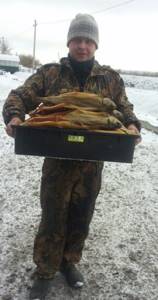
If you are looking for fishing bases in the Chelyabinsk region and the Ural region, paid fishing, trout fishing, come to RK Azart for new sensations and an excellent catch!

We are waiting for your calls every day (7 days a week) from 8ºº to 18ººh. by phone We will be happy to make your vacation carefree and unforgettable.
A little theory about carp fishing.
It is easy to spot carp in a reservoir - you just need to look carefully at the surface of the water to find where the fish are feeding. In summer, carp should be looked for at depths of 2-5 meters. But with the onset of autumn, when the water temperature drops, the fish prefers deeper places. In winter, when the cold sets in, the carp drops to a depth of below 10 meters. Resident carp do not like to move long distances across a body of water. Even during spawning, it does not move far from its usual place. In reed thickets you can often find young carp, whose age usually does not exceed 3 years. They remain in the creeks for the winter, and in the spring they move to the bays along with older individuals. This is due, first of all, to a large amount of food, as well as to the spring flooding of rivers - carp look for calm backwaters, avoiding strong currents. Large fish usually stick to deep holes, only venturing into shallow water to feed. The ideal place is pits with a clay bottom, which are littered with snags. The carp avoids the bottom covered with silt. In rivers, such pits are located under cliffs, at bends in the riverbed. You can also find carp between the pilings of bridges spanning rivers. In reservoirs and ponds you can often spot carp on the surface of the water. During extreme heat, the fish often stands in the shade cast by the trees, protruding a quarter of the water. In a pond, carp are easy to spot as they often jump out of the water. Moreover, it is almost impossible to confuse it with other types of fish, since it jumps out of the water entirely and makes a sound similar to a frog croaking. The height of the vertical jump can reach 2 meters. It is not known what causes these jumps, but they enable the fisherman to determine the presence of carp in the reservoir. But such fish activity does not mean that fishing will be successful. If the carp jumps, but there is no bite, then you should expect a quick change in weather conditions. The carp jumping out of the water indicates that its spawning has ended. The fish will make such jumps in the morning and evening hours throughout the summer, as well as in the first weeks of autumn. In the summer, carp feed at night, so at this time it can be found in shallow water, from where after 9-10 o’clock in the morning it will go deeper. At the end of summer, it is better to catch carp in the evening and morning hours. By this time, the fish has already managed to gain the required supply of fat, so it feeds less, remaining in the pits not only during the day, but also at night. Carp is a schooling fish. The number of individuals in a school usually does not exceed 2-3 dozen, but sometimes it can reach up to a hundred fish. Carp gather in such large schools during preparation for wintering. While moving, the fish do not move in a group, but in a line one after another. At the same time, carp is a rather timid fish and moves alone in large waves and strong winds.
Uvildy
This fairly deep lake is located near Kyshtym and is ideal for beginner fishermen. Since the 1970s, it has been included in the list of the most valuable bodies of water in the world.
The lake is rich in fish: carp, pike, pike perch, crucian carp are just some of its inhabitants. In summer, large pike are caught from boats in the bays; in winter, whitefish and ripus are caught in deep areas. By the way, in the 19th century a pike weighing 56 kilograms was caught here.
Where to catch. 5 most fishing places in the Chelyabinsk region
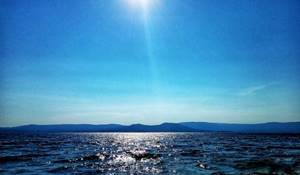
Uvildy. Where to catch. 5 most fishing places in the Chelyabinsk region
Where is carp found in the Chelyabinsk region?
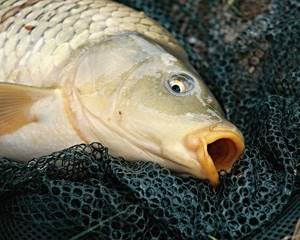
His Majesty carp is the most popular fish in the Southern Urals! Why carp? Firstly, this is the main representative of the large carp family, which by its nature is well adapted to our climatic conditions. From here it quickly gains marketable weight. Secondly, its fish flesh has wonderful taste. And if your head is the size of a chef's hat, you can't avoid licking your own fingers. Well, and most importantly, this is a worthy fighter, when fishing, fishing rods crack and knees shake. What else do we fishermen need?!
Simple (carp), mirror, naked - there are many varieties of carp, but the essence is the same. For the most part, they are all “brothers and sisters”, born in “test tubes” of fish factories and released into the wild. Naked, mirrored - what's the difference! Only lazy cooks believe that mirror carp is tastier than regular carp. Misconception! It just has fewer scales and is easier to clean. But it is for sure that carp caught from different waters have different taste qualities.
Such simple categories: the size and depth of the reservoir, the chemical composition of the water and food supply, the presence of flowering flora and rotting flooded forest - all this affects the taste of underwater inhabitants! And it’s sad when the cooked fish soup smells not like fire, but like dust. But what is much worse is that you cannot see the presence of radiation and heavy metals in the eyes of the caught fish. Well, okay, the foreplay is over, and as Ostap Bender used to say: “Mother, let’s go to the bins!”
Lake Tishki. Carp 0.3–5 kg, ticket 300 rubles. The fish is clean and tasty. Today, the carp are not in the reeds, but in the lake, so normal fishermen have long been based on the clean reeds (100–800 meters from the lake edge), and only the booties still huddle close to the shore, exterminating 200-gram small fish.
Lake Urefty. Carp 0.6–3 kg, ticket 150 rubles. Despite the decent weight, the carp here is not fat. Apparently, this is due to the “dead” food supply. Today the best fishing is using donkeys (casting rods, spinning rods) from a boat in the area of the spring, 200–300 meters from the shore. The reeds have small change.
Lake Kainkul. Carp 0.2–5 kg. I haven’t been there myself, I won’t lie. But my friends brought back a lot of fish and impressions from there. Worth a try!
Lake Chebakul. Carp 0.8–5 kg. The fish is fatty and tasty. Fishing in the far right bay (from the village of Chebakul) and in the clean one, not far from the bay. Apparently, the carp in this reservoir were not completely swept away, so they still stick to shallow depths.
Lake Uelgi. Carp, silver carp, grass carp (0.8–24 kg). It’s a good lake, but the funny thing is that when hunting for predators, only bee-eaters visit it. Apparently, no one knows that this reservoir has been actively stocked with fish from the carp family for a long time, and the fish here are truly trophy! All you have to do is adapt!
Lake Aydykul (Aktobe). Carp 0.5–16 kg, ticket 350 rubles. Fishing on large patches of grass. The lake water area is large, so it is advisable to have an outboard motor for the boat.
Lake Agachkul (Sultaevka). Carp 2–12 kg, the biggest gourmet in the Chelyabinsk region. Here, regular canned corn often doesn't work. Today the fish take only semolina with a worm attached, and tomorrow - on steamed “stars” from homeless bags. Fishing for donkeys from the shore, and luck does not come to everyone and only in a stormy surf.
Lake Sagishty (Sultanovo). The carp, 2–10 kg, was stocked six years ago, and since then, except for local villagers, no one has caught it. Apparently, the proximity of the Russian Techa and the general fear of radiation had an effect. Recently it turned out that the “Mayakovsky trace” did not touch this reservoir, and a real pilgrimage began here. Of course, in six years the fish has grown considerably, but, as it turned out, it is not easy to catch it. In any case, the monsters of this reservoir are too tough for booties - there are too many fishing subtleties!
Lake Tirikul. Carp 5–16 kg, caught on a fishing rod only in favorable weather and only in certain reed places. Fishing here is somewhat akin to hunting a snow leopard. Just as forbidden and often hopeless! You can feed fish for weeks and not see a single bite. But signs prohibiting commercial fishing are on all banks. Regarding carp, this lake is only for “pros”.
Lake Treustan. Carp 0.6–14 kg, until July, in terms of its taste, it is simply a delicacy. But with the onset of summer heat, flooded forests begin to “wander.” As a result, the fish also begins to smell of dust. At the end of August, the water cools down, and everything returns to normal - the carp becomes edible again. From the story of the fishermen: this season, in the middle of the lake, they picked up a drifting net, torn from the anchors, in which there was a carp weighing 34 kilograms. I don’t know whether they’re lying or not, but what I bought for is what I sold for. So draw conclusions about the size of the local fish, which sometimes breaks fishermen’s fishing rods (including me).
Lake Atkul. Carp 0.6–8 kg, quality fish relative to the frying pan. The ticket costs 150 rubles. If you approach fishing (from a boat) in a working way (0.2–1 km from the shore) plus 4–6 donks (spinning rods), you can load the fish tank well. In this case, you need to look for carp by its characteristic splashes (candles). In the absence of these (blind search), you will have to work hard: each stop with thrown gear takes one and a half to two hours. If there are no bites, you need to move 100–200 meters towards a gradual increase in depth. Empty again - that means further... Of course, this type of fishing is not for amateurs who are accustomed to drying their “fins” on the shore, sitting with beer under umbrellas.
Lake Tukwanda. Carp 1–12 kg, round and from the outside somewhat reminiscent of bream. The fish, as in every bitter-salty lake, is very tasty. We've been here twice - the fishing is excellent! The left side is a continuous spawning shoal, the right side has decent depths. The problem is that this lake is under the jurisdiction of the military (a training ground), but there is a rumor that the lake has been opened.
You can also catch carp in the lakes Bolshoy Kremenkul, Kurochkino, Sineglazovo, Kasargi, Shelomentsevo, in the ponds of Nizhniye Karasey... So where can you go fishing to catch a wonderful fish, whose name is carp?! I will say without any secret - the direction is not important! The most important thing is that we were all born in the Southern Urals, in a Russian corner of hundreds of rivers and thousands of lakes. By and large, we have nowhere and no need to go - we’ve been in a cool place since birth!
Order Cypriniformes
One of the most numerous orders of bony fish. Consists of 6 families, includes 3268 species, most of which are freshwater. Cypriniformes are found on all continents except Antarctica. But there are especially many of them in the Northern Hemisphere.
Some of these fish are characterized by rather bright colors, which are most pronounced during spawning. In addition, the bodies of male cyprinids also become covered with epithelial tubercles (become rough).
In the list of fish of the Chelyabinsk region, this order is the largest, it includes 4 families and 27 species. Six fish from this list—grass carp, silver carp, carp, silver carp, bighead carp and buffalo—were introduced artificially into the region’s water bodies.
Family Balitoriaceae
Most fish of this family live in the tropics and subtropics of Asia; in the European part of the continent they are represented by only a few species, 4 of which are found in Russia. All Balitoridae lead a benthic lifestyle and are small in size.
Two species have been recorded in the rivers of the region: barbel char and Siberian barbel char. The second of them was previously considered a subspecies of the first, but recent genetic studies have shown that these are two different fish, although they are closely related to each other.
Barbel loach

The barbel loach is a small fish that inhabits small rivers and streams with clean water and a pebble-sandy bottom. It is also found in ponds, lakes and the lower reaches of some large rivers. The usual dimensions are 10-12 cm with a weight not exceeding 20 g. It can grow up to 18 cm in length and 25 g in weight. Leads a benthic lifestyle and is numerous in its habitats. Area: Europe.
- Where it is found: rivers of the Caspian basin (upper reaches of Chusovaya, Ufa, Ural, as well as their numerous tributaries).
Siberian barbel char
In appearance and in its lifestyle it is very similar to an ordinary mustachioed loach. Its only difference is its distribution area. The Siberian mustachioed char lives in rivers and reservoirs of Siberia.
- Where it is found: Ob basin (upper and middle reaches of the Sinara, Miass, Uy, Ayat rivers, their tributaries).
Family Loaches
Among the fish of the region, loaches are represented by two species - loach and spined loach.
Loach

It lives in swampy reservoirs, as well as in river oxbows, branches and creeks - where the current is slow or completely absent. Prefers a muddy bottom and dense thickets of underwater plants. The usual dimensions are 20 centimeters with a weight of 140 grams, some individuals grow up to 35 cm in length. Thanks to the ability of intestinal respiration, the loach can absorb oxygen from the air, which allows it to live in water bodies where crucian carp cannot survive. Distributed in the basins of the North, Baltic, Black Seas, as well as in the Volga basin.
- Where it is found: as to whether the loach is found in the Chelyabinsk region, ichthyologists do not have a common opinion. There is information about the capture of this fish in certain reservoirs, despite the fact that the eastern border of its range is located far beyond the region.
Shchipovka

The size of the spined loach is small - usually its length does not exceed 12 cm and weighs 8-10 g. It lives in flowing reservoirs and rivers with a hard bottom, preferring sandy places with a slow current. Just like the loach, it has intestinal respiration, but not as effective.
- Where it is found: rivers of the Caspian and Ob basins (Ufa, Yuryuzan, Sim, Ural, Sinara, Techa, Miass, Uy, Ayat and some of their tributaries).
Family Cyprinidae
The list of fish in the Chelyabinsk region includes 22 species of this family, 6 of which are not local.
White amur
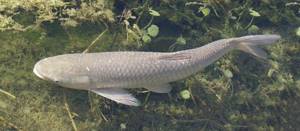
A large fish, reaching a length of 1.2 m and weighing 32 kg. It feeds on higher plants - both aquatic and terrestrial (during floods). Grass carp was originally found in East Asia. Starting from about the middle of the last century, it was intensively populated in reservoirs outside its natural range, including for the purpose of reclamation of reservoirs (cleaning of algae).
- Where it is found: Verkhneuralskoye, Troitskoye and Yuzhnouralskoye reservoirs, lakes Inyshko (Turgoyak, Miasssky district), Myrkai (Krasnoarmeysky district), Pykhovo (Kaslinsky district), Semibratsky (Zlatoustsky district), Sineglazovo (Sosnovsky district), Treustan (Krasnoarmeysky district), Uzunkul (Sosnovsky district), Simsky ponds (Asha MR), Yuryuzansky.
- Paid fishing: lakes Maly Agardyash (Karabashsky district), Alabuga (Burlak, Karabashsky district), Atkul (Atkul, Yetkulsky district), Bolshoy Terenkul (Chebarkulsky district), Kuntudy (Kunashaksky district), Takhtalym (Kunashaksky district), Irdyaginskie ponds (Argayashsky district), Tishki (Kunashaksky district), Uelgi (Kanzafarova, Kunashaksky district), Urefty (Sosnovsky district), Shugunyak (Kunashaksky district).
Verkhovka

Small fish, the size of which usually does not exceed 6-10 centimeters. It lives in rivers - in areas with slow flows, as well as in ponds and some lakes. Numerous everywhere. Previously, its range in the region was limited to the Kama basin, but over time (not without human help) it penetrated into the basins of the Urals and Ob. Now the verkhovka is a common sight there.
- Where it is found: in rivers - almost everywhere (the basins of Ufa, Ural, Sinara, Techa, Miass, Uya, Ayat). There is also verkhovka in many lakes, for example, in Bolshoy Sarykul (Emanzhelinsk), Bolshiye and Malyye Irdyaga (Argayashsky district), Sineglazovo (Sosnovsky district), etc.
Chub
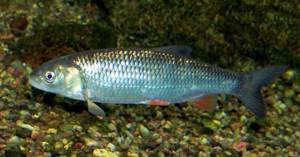
Chub is a medium-sized river fish. The usual weight is from 300 g to 1 kg with a length of 30-40 cm; individuals weighing 2-3 kg are much less common. Inhabits fast-flowing rivers, preferring areas with rocky and pebble bottoms. The natural range of the chub is quite wide and extends from Western Europe to the Ural Mountains.
- Where it is found: the rivers Ufa, Yuryuzan, Sim, Ural and their tributaries.
River minnow
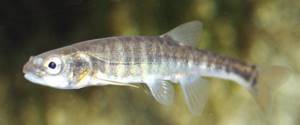
A small fish that inhabits rivers with clean water. It is found in areas with shallow depths and a sandy or pebble bottom. Distributed quite widely, numerous everywhere, and lives in large flocks.
- Where it is found: in streams, small and medium-sized rivers of the region - with conditions suitable for it.
Lake minnow
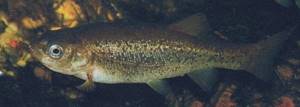
Inhabits stagnant bodies of water, including those heavily overgrown with underwater vegetation. Leads a bottom-dwelling lifestyle. Usual sizes are 10-15 cm with a weight of no more than 100 grams.
- Where it is found: quite rare in the region. Recorded in some lakes of the Ob basin.
Gorchak
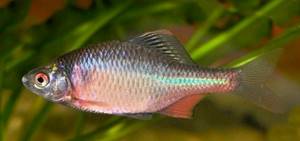
A small fish that inhabits stagnant reservoirs and sections of rivers with slow flows. The usual size is 7-8 cm with a weight of 3 to 8 g. Males are brightly colored during spawning. Gorchak is interesting because it lays eggs in the mantle cavity of bivalve mollusks.
- Where it is found: single specimens of this fish have been recorded in the Ural River and some of its tributaries.
Gustera
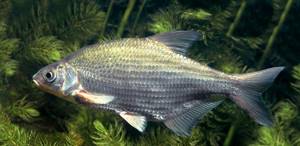
It lives in lakes and reservoirs, as well as in sections of rivers with slow or no flow. Prefers shallow, well-warmed by the sun places with a muddy or clay bottom and dense thickets of underwater plants. The usual dimensions are 25-30 cm with a weight of up to 500 g. Some individuals grow up to 35 cm in length and 1.2 kg in weight.
- Where it is found: common in the Ural River. Perhaps there are also in the rivers of the Kama basin, for example in Ufa. Recorded in the Kasli lakes.
Dace
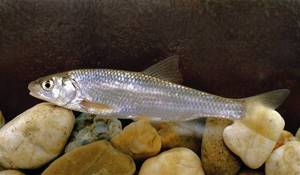
Dace is a small river fish, closely related to the chub. Inhabits small and medium-sized rivers, preferring places with fast currents and a hard bottom. It usually lives in the bottom layers of water. The range of the dace is quite wide and occupies almost the entire northern half of Eurasia.
- Where it is found: found in many rivers of the Chelyabinsk region, including Ufa, Yuryuzan, Ural, Sinara, Miass, Uy, and many of their tributaries.
Asp
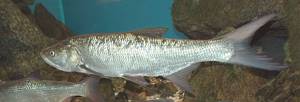
Asp is a predatory fish that inhabits rivers and some reservoirs. It reaches a length of 80 cm and weighs 5 kg; there are known cases of larger specimens being caught. Usual sizes are no more than half a meter and weigh up to 3 kg.
- Where it is found: found in Ufa and some other rivers of the Kama basin. Also lives in the Urals. Recorded in the Nyazepetrovsk Reservoir.
Golden crucian carp
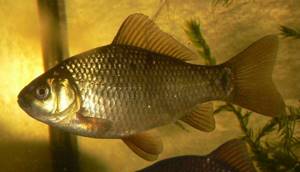
Inhabits stagnant bodies of water, as well as (much less often) branches and creeks of rivers. Usual sizes are 10-25 cm with a weight of up to 500-600 g. It prefers a muddy bottom, is unpretentious to the oxygen content in water, due to which it can live in small overgrown lakes and oxbow lakes of rivers. Among the fish of the Chelyabinsk region - one of the most widespread species.
- Where it is found: in most lakes in the region (in some - the only species), in many ponds and reservoirs.
Silver crucian carp
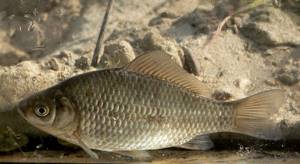
Silver crucian carp is in many ways similar to the previous species, except that it is more demanding on the level of oxygen dissolved in water. It is also much more common in rivers. Initially inhabited the territory of China, Japan, the islands of Taiwan and Hainan. Several centuries ago they began to breed it artificially, thanks to which it spread throughout almost all of Eurasia.
- Where it is found: in many lakes and reservoirs in the region.
Rudd
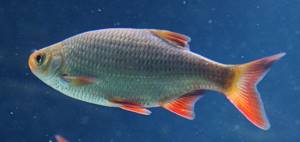
A small fish, rarely reaching a length of 40 cm and a weight of 2 kg. Usually its dimensions do not exceed 20 cm, and its weight is 300 g. It lives in stagnant bodies of water, less often in rivers with a slow flow, preferring areas with a muddy bottom and developed vegetation.
- Where it is found: common in the Ural basin. Available in lakes Bolshoi and Maly Bugodak (Verkhneuralsky district), Verkhneuralsky reservoir. Some fishermen claim the presence of rudd in the Nyazepetrovsky and Troitsky reservoirs.
- Paid fishing: Lake Koshkul (Miasssky District), Butubay Pond (Kizilsky District).
Bream

Lives in rivers and reservoirs, prefers deep areas with slow currents and muddy bottoms. Usual sizes are 25-45 cm with a weight from 500 g to 1.5 kg. Less common are individuals weighing from 2 to 3 kg, extremely rarely - up to 5 kg. The maximum known weight is 9 kg with a length of just under half a meter. The natural range is the European part of the continent.
- Where it is found: rivers and reservoirs of the Kama basin (Ufa, Yuryuzan, Sim, Ural and some of their tributaries). Artificially populated in the Tobol basin - found in the Sinara, Techa, Miass, Uy and Ayat rivers, as well as in reservoirs and non-dammed lakes with a favorable oxygen regime.
Tench
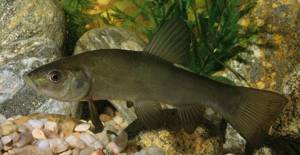
Tench is a medium-sized fish that inhabits lakes, ponds and rivers. The main condition for its habitat is the presence of areas of the bottom with silt and developed underwater vegetation. It grows up to 63 cm in length and 7.5 kg in weight, but its usual dimensions are more modest - up to 30 cm with a weight of no more than one and a half kilograms.
- Where it is found: rivers - middle reaches, flat and foothill areas. Reservoirs - Argazinskoye, Kialimskoye, Troitskoye, Shershnevskoye, Yuzhnouralskoye. Ponds - Verkhneufaleysky, Metlinsky, Minyarsky, Polikarpovsky, Simsky, Sukhovyazsky. Lakes - Akakul (located on the border of the Argayash district and the Kyshtym municipality), Bolshoye Akulya (Kyshtym municipality), Anbash (Kaolinovy, Kyshtym municipality), Barakhtan (Karabashsky municipality). Verkhneuralsky district: Bolshoi and Maly Bugodak, Bolshoye Chebachye. Itkul (Verkhneufaleisky municipal district), Bolshiye Kazgaly (Kyshtym municipal district). Kasli district: Dolgoe, Bolshie Allaki, Bolshie Kasli, Kirety, Bolshoi Kisegach, Okunkul, Rependy, Svetlenkoe, Silach, Sungul. Kysykul and Turgoyak (Miass). Chebarkul district: Baraus, Elovoe, Bolshoye and Maloye Miassovo, Misyash Bolshoi and Maly, Sunkul, Chebarkul. Malaya Nanoga (Ozersky GO). Sineglazovo and Smolino (Sosnovsky district). Uvildy (located on the border of Argayash and Karabash districts), Ulagach (Argayash district).
Gudgeon
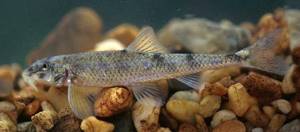
The rivers in which the gudgeon are found can be called relatively clean - this species is very sensitive to water quality. It inhabits watercourses with rocky, pebble and sandy bottoms, avoiding places with slow currents and muddy areas. Less commonly, gudgeon can be found in ponds and lakes. By itself it is small - usually 12-15 cm long.
- Where it is found: in the upper and middle reaches of most rivers in the region.
Roach
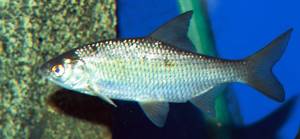
Roach (other names: chebak, soroga) is a common species that inhabits flowing reservoirs and rivers, with the exception of stagnant lakes and mountain streams with rapid currents. In ponds and reservoirs it is small and numerous; in rivers it is not found so en masse, but for all that, its size here is noticeably larger. Loves places overgrown with aquatic vegetation. It can reach a weight of 1.3 kg with a length of 35 cm, but its usual dimensions are no more than 20 cm and weigh up to 100 g.
- Where it is found: rivers of the region (except for the smallest headwaters and mountain rivers), ponds and reservoirs. There are roaches in many lakes.
Podust Volzhsky
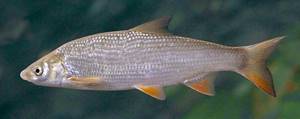
Medium sized fish. Podust lives exclusively in rivers, preferring the main channel to tributaries. The usual weight is no more than half a kilo with a length of up to 30 cm; occasionally there are individuals up to 2 kg in weight, and even larger. Previously numerous, now rare.
- Where it is found: rivers of the Caspian basin - Ufa, Sim, Ural. May enter (in spring) some of their tributaries.
Carp (carp)
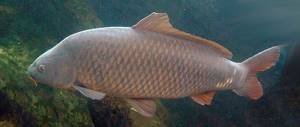
Carp in the Chelyabinsk region is a non-native, acclimatized species. In the last century, it intensively populated the lakes and reservoirs of the region, took root in many of them and reproduces. It reaches decent sizes - more than a meter long and weighs up to 32 kg, but such giants are rare, and the usual weight in catches is 1-3 kg with a length of up to half a meter.
- Where it is found: in most lakes and reservoirs in the region.
White silver carp
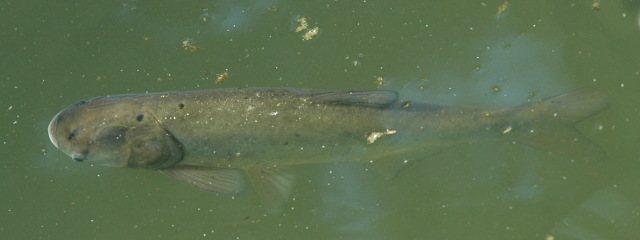
Large fish introduced from the Amur basin. Reaches a length of 1 m and weighs 16 kg. It feeds on phytoplankton - single-celled algae that cause water blooms. Can be used for water reclamation purposes.
- Where it is found: Verkhneuralskoye, Troitskoye and Yuzhnouralskoye reservoirs, Simsky pond, lakes Kambulat, Sineglazovo, Treustan.
- Paid fishing: lakes Alabuga (Karabash district), Atkul (Etkul district), Bolshoi Terenkul (Chebarkul district), Koshkul, Tarhun (Miass), Uelgi (Kunashak district).
Bighead carp
It differs from the previous type in color, but otherwise is completely similar to it. It is also launched into reservoirs to clean them of single-celled algae.
Bleak
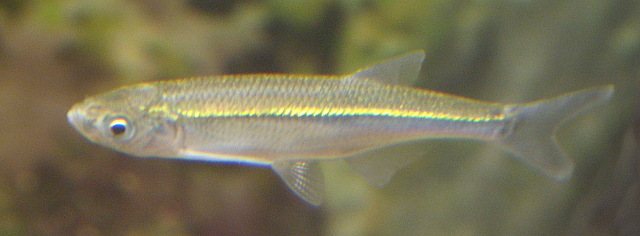
Bleak is a small river fish that lives in the surface layers of water. It reaches a length of 25 cm with a weight of 60 g, the usual size is 15-20 cm. Previously it was found only in the Caspian basin, but has now penetrated (not without human help) into the Ob basin.
- Where it is found: in the basins of the Kama (Ufa, Yuruzan, Sim) and the Urals - a common species inhabiting rivers with moderate currents and reservoirs built on them. In the Tobol basin (Sinara, Techa, Miass, Uy, Ayat) it is also found, but much less frequently.
Ide

Ide is capable of growing to a decent size - 1 m long and weighing 8 kg, but most often you come across individuals weighing up to 1-2 kg with a length of no more than half a meter. Inhabits rivers and lakes, prefers slow currents to fast currents, and silt and clay to areas with a hard bottom.
- Where it is found: the middle course of rivers in the region - foothill and lowland areas. Recorded in lakes such as Bolshie Allaki, Kirety, Rependy - located in the Kasli district, Zyuratkul (Satkinsky district), Itkul (Verkhneufaleysky GO), Maly Bugodak (Verkhneuralsky district), Bolshoye and Maloye Miassovo, Chebarkul - located in the Chebarkul district, Bolshaya and Malaya Nanoga (Ozersky GO), Surtanysh (Kunashaksky district), Turgoyak (Miass GO). Available in reservoirs - Argazinsky, Verkhneuralsky, Dolgobrodsky, Nyazepetrovsky, Troitsky, as well as in Satkinsky and Sukhovyazsky ponds.
- Paid fishing: lakes Alabuga (Kaslinsky district), Maly Agardyash (Karabashsky district), Koshkul (Miass), Uspenovskoye reservoir (Chesmensky district).
Chukuchanov family
Representatives of this family are found in North America. Among the fish of the Chelyabinsk region, it is represented by the only introduced species - the large-mouthed buffalo.
Buffalo largemouth

The natural habitat of this fish is North America. In the last century, the buffalo was introduced into many reservoirs in Russia, but did not take root everywhere - due to its demandingness regarding water temperature (it is considered a heat-loving species).
- Where it is found: inhabited in the Yuzhnouralskoye and Troitskoye reservoirs.
- Paid fishing: Lake Urukul (Kunashak district).
Free lakes for fishing in the Chelyabinsk region
Some anglers don't like paying to fish. They are more interested in catching fish in wild bodies of water themselves. Others prefer paid fishing, since they do not like to sit in the thickets and catch fish that they may not catch all day. Both will enjoy fishing in the Chelyabinsk region on the lakes, since there are many good paid and free reservoirs.
Abatkul, Akakul, Atkul
A small pond whose banks are overgrown with reeds. Mostly crucian carp are caught on the hook.
The area of the reservoir is about ten square kilometers. Depth no more than three meters. The bottom is sandy, sometimes muddy or rocky. Winter fishing is popular on the lake. Perch, bream and pike are caught using a jig. In summer, they fish from the shore using spinning rods.
Quite a large lake with an area of more than fifteen square kilometers. The reservoir is not too deep; places more than three meters deep are rare. It’s quite convenient to fish here, because the shore is flat.
Fishing on Atkul, as a rule, is done from boats, but there are many fishermen on the shore. Here you can catch large carp. It is caught with bottom fishing rods using bread or corn.
In addition to carp, Atkul also has:
Buldym, Irtyash, Karasevo
The average depth is two to three meters. The reservoir is inhabited by crucian carp, minnow, rotan.
The area of the reservoir is about thirty square kilometers. The depth is generally no more than five meters, but in some places up to sixteen. On the banks of the Irtyash there are rental points for boats and catamarans, from which you can catch ruffe, perch, roach, ide, burbot, pike, and whitefish.
The size of the reservoir is three by one and a half kilometers. The lake is overgrown with reeds, but some areas of the shore have good fishing spots. Both locals and guests of the region fish here. Karasevo is home to pike, chebak, minnow, and crucian carp. According to anglers, large specimens are often caught on the hook.
Myrkai, Turgoyan, Chebarkul
The lake measures approximately three by two kilometers. The depth is small, up to five meters. Fishing here is not easy, as there is a lot of algae. But the lake is home to grass carp, pike and whitefish. You can also catch crucian carp, perch, and carp.
Deep lake, up to forty meters in places. In addition to gudgeon and ruffe, the following are found here:
- crucian carp;
- whitefish;
- tench;
- pike;
- cheban;
- burbot;
- ide;
- trout.
The lake is medium in size. The depth is about seven meters, in some places up to thirteen. There are several islands on Chebarkul that are convenient for fishing. Here it is:
What kind of fish is found in the Chelyabinsk region
There is a lot of fish in the Urals, and the Chelyabinsk region is no exception. Various fish are found in local reservoirs. Particularly lucky fishermen manage to catch rare specimens, but no one is safe from a trophy catch, even a beginner. Local rivers and lakes contain:
- Char;
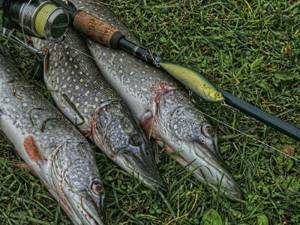
- Loach;
- Pinching;
- White amur;
- Verkhovka;
- Chub;
- Minnow;
- Guster;
- Dace;
- Asp;
- crucian carp;
- Rudd;
- Bream;
- Tench;
- Roach;
- Gudgeon;
- Carp;
- Silver carp;
- Bleak;
- Smelt;
- Taimen;
- Trout;
- Whitefish;
- Perch;
- Zander;
- Pike;
- Burbot.
As you can see, the fish are very different, so you need to choose the appropriate gear. The region is famous for its taimen fishing; all fishermen dream of catching the river giant. But its dimensions are sometimes very large, so you need to choose powerful tackle.
Paid fishing on lakes
Paid lakes in the Chelyabinsk region are well suited for successful fishing. Reservoirs are regularly stocked with fish, so you can be guaranteed to catch good specimens. In addition, paid reservoirs in the Chelyabinsk region are relatively inexpensive. For little money you can go fishing well.
Aydykul, Aktobe, Alabuga
The lake is medium in size, up to five meters deep. There is a recreation center on the shore of Aydykul. Fish are caught both from the shore and on boats. The lake contains:
On the downside: many people vacation on Aydykul on weekends, and sometimes finding a good place for fishing is not easy.
Area - twenty square kilometers. Depth - four to five meters. The reservoir is often stocked with fish, so large crucian carp, pike, and carp live here. And there are also roaches and whitefish. There is a recreation center on the shore of the lake.
The average depth is five meters. There are holiday houses on the shore of the reservoir. The lake contains valuable species of fish:
And here you can catch crucian carp, tench, carp, perch, pike, and grass carp.
Baynaush, Kaldy, Tatysh
The area of the lake is more than eight kilometers, the depth is one and a half meters . Despite the shallow depth, there are a lot of fish here. Some lucky fishermen managed to catch carp weighing three kilograms here. And also in Baidaush there is:
Reviews of this lake vary, but most anglers love it.
Quite a large lake, about twenty kilometers square. Depth - up to seven meters. They fish here both from the shore and on boats. Found in Kaldy:
Fishermen love this lake, because rarely does anyone return from here without a good catch . But there are a lot of people who want to fish here, so there is not always a good place for fishing.
A small body of water with an area of about two kilometers square. You can pitch a tent on the shore. And there is also a recreation center.
Lake Tatysh is home to large carp, pike-perch and perch. They fish here both from the shore and on boats.
In which Chelyabinsk lakes are crucian carp found?
There are about 4,000 lakes in the Chelyabinsk region, 53 of them are large, with a water surface area of more than 10 km². All names of reservoirs come from the Tatar and Bashkir languages. The most common parts of the names “elga” and “uzyan” in translation mean a river, “kul” means a lake.
Did you know? Since female goldfish grow faster than males, only females are used in industrial breeding. Spawning occurs with males of related fish, so the offspring are always female.
Abatkul
Abatkul is located in the northeast of Chelyabinsk, 110 km from the city. A small freshwater lake with an area of about 2 km² is located in a coniferous forest. The coastline has areas with reed thickets. The most popular types of fish are silver and gold carp. There is an opportunity to set up a tent on the shore. Fishing on the lake is free. The nearest populated area is the village of Kirdy, located 6 km away.

The bottom of Lake Abatkul is silty and rich in sapropel. Sapropel is a healing mud formed at the bottom of a reservoir from rotted aquatic vegetation, living organisms and plankton.
Alabuga
Alabuga is a fresh lake, which is located in the Krasnoarmeysky district of the Chelyabinsk region at a distance of 90 km from Chelyabinsk. The name Alabuga comes from the Bashkir word, which means perch. The area of the water surface is 7.5 km². The average depth of the lake is about 3 m. The bottom is muddy. The coast is covered with reeds. Access to the lake is good, as there is a road from the north-eastern part.
Find out what time is best to catch crucian carp.
On the southern coast there is a large settlement of Alabuga. In order to fish on the lake, you must pay a fee. There are houses on the shore that can be rented. There is a smokehouse on site. You can use it for a fee. In addition to crucian carp, the lake is home to perch, roach, pike, grass carp, sturgeon, trout, sterlet, carp, and burbot.
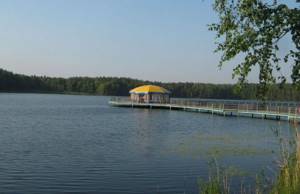
Buldym
Lake Buldym is located in the Kasli district of the Chelyabinsk region, 16 km from the administrative center. The area of the water surface is 2.5 km², the depth is about 3 m. The entire coast, except the southern part, is very swampy. The main type of fish is large crucian carp weighing up to 2 kg.
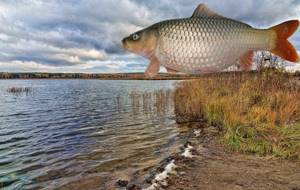
Fishing on the lake is free.
Tishki
Tishki is a lake located in the northeast of the Chelyabinsk region, 35 km from Chelyabinsk. It has an elongated shape with an area of 25 km², a depth of about 2.5 m. There are many snags at the bottom. Access to the shores in wet weather is difficult. The main type of fish is carp, so crucian carp is rare. You can also catch peled and grass carp. Tenants of the reservoir stock it with fish every year.
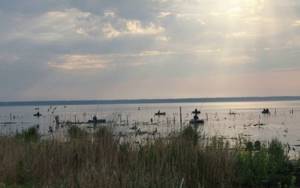
Fishing is carried out after payment is made both from the shore and from boats.
Tatysh
Tatysh is a freshwater lake located in the north of the Chelyabinsk region . The name Tatysh comes from the Bashkir word, which means calm and peace. An oval-shaped reservoir with an area of 170 hectares. A mixed forest grows on the shores of the lake. From the south the coastline is covered with reeds. The bottom structure is muddy. The main fish is carp, so crucian carp is much less common. Fishing on the lake is paid.
